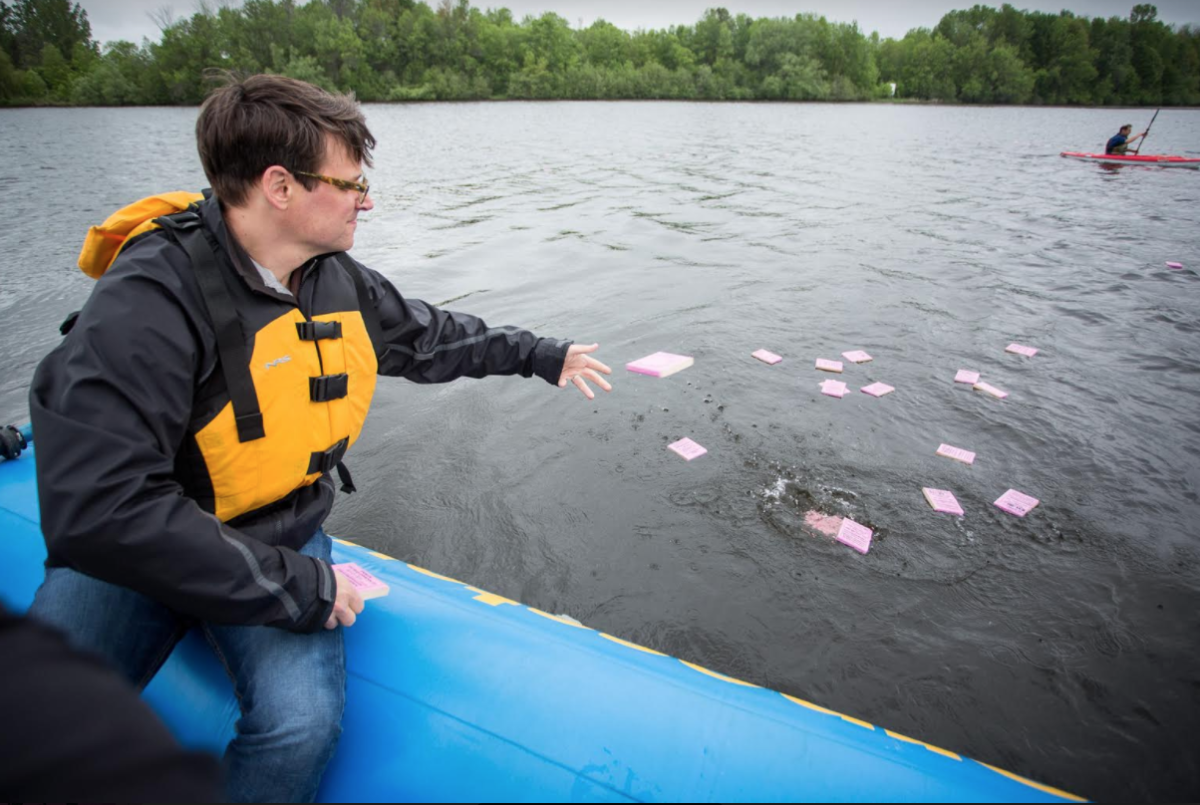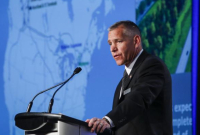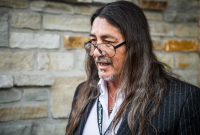Canada's National Energy Board has rejected recommendations from big business and big oil, agreeing for the first time in its history to consider both upstream and downstream greenhouse gas emissions while reviewing a major pipeline project.
The federal regulator confirmed Wednesday that "indirect" heat-trapping pollution from TransCanada's Energy East pipeline will be considered during upcoming hearings for the proposed project, which aims to ship more than a million barrels of oil per day from the Canadian Prairies to the East Coast.
That means panel members will take into account emissions that would be produced not only during the pipeline's construction and operation, but in the refining, processing and transportation of its oil as well. The NEB typically considers "direct" greenhouse gas emissions during pipeline reviews, but the impact of "indirect" emissions produced down the road is a historic first.
In its determination of whether the project is in the public interest, the panel will also consider Canada's mix of climate change policies, including provincial energy and greenhouse gas strategies, policies laws and regulations. It's another first for the NEB, the regulator confirmed on Wednesday.
"Today’s decision establishes the foundations for a thorough assessment based on science, traditional knowledge of Indigenous peoples, and other relevant evidence," it said in a press statement.
"A broad range of topics will be covered by the NEB’s assessment, including Indigenous participation in the projects throughout their lifecycles, landowner and municipal considerations, cumulative environmental effects, as well as socio-economic elements."

Industry lobbying efforts failed
The Energy East pipeline is the largest proposal of its kind in North American history. If approved, the 4,500-kilometre project would ship up to 1.1 million barrels of oil per day from producers in Alberta, Saskatchewan and North Dakota to refineries and marine ports in Quebec and New Brunswick.
On Wednesday, the NEB confirmed the list of topics that would be considered in upcoming hearings for the pipeline after a public comment period that included more than 800 submissions. Also on the list are the proposal's possible impacts on marine shipping, along with the environmental and social impacts of power lines that will connect Energy East's pump stations.
Based on public feedback, the NEB has expanded and clarified its commitment to take the rights and interests of Indigenous peoples into account, and address concerns about oil spills by making "accidents and malfunctions" a distinctive issue on the panel's list.
The regulator did not however, heed the industry requests to keep upstream and downstream emissions out of the review.
Earlier this year, both TransCanada and the Canadian Chamber of Commerce wrote letters to the NEB in an attempt to discourage it from considering such emissions during hearings for the massive pipeline, which would cross some 3,000 streams, rivers, and waterways on its way from the oilpatch to eastern Canada.
On May 17, TransCanada's legal team wrote that consideration of GHGs would be "completely redundant and unnecessary," given that such analysis falls within the purview of the federal government. It also suggested that since indirect emissions have not been considered in previous pipeline reviews, to do so for Energy East would conflict with the regulator's goals of achieving "continuity, consistency and a degree of predictability."
The Canadian Chamber of Commerce, which represents 200,000 businesses on national and international issues, made similar arguments on May 31, adding that "the most effective approach to managing greenhouse gas emissions from oil production, refining, or use is for government to regulate these areas directly." In an interview, the chamber's director of environment and natural resources policy, Karina Marsh, said it stands by those arguments today.
"What we're saying is that TransCanada is asking to build a pipeline, so you should look at the greenhouse gas from the pipeline," she told National Observer. "That's appropriate, that should be done, that's an environmental impact we should take into account.
"But the production of the oil and gas — that's a completely different industry, with completely different companies who do that. Because that's out of the control of TransCanada, it should not be part of the project review process. It should be dealt with through government policies and legislation specifically targeted towards those business, which the governments of Alberta and Canada have done already."
In an emailed statement, TransCanada declined to comment on the list until it had time to assess it thoroughly.
"We are going to take the necessary time to review the issues list and understand the potential impacts on the project," said spokesperson Tim Duboyce.
In an email, NEB communications officer Marc Drolet acknowledged that upstream and downstream greenhouse gas emissions are "beyond the control" of project applicants, and are not part of the "designated project(s)" as defined by the 2012 Canadian Environmental Assessment Act (CEAA). But given the public's interest in such emissions, from an environmental perspective, he said the board concluded that they may be relevant to its "public interest determination under the NEB Act."
The panel will consider upstream and downstream emissions under a section of CEAA that allows it to take into account "any other matter relevant" to its environmental assessment. Drolet said the NEB will release more information on how it plans to do that shortly.

The review that started from scratch
The Energy East pipeline is hotly-contested by environmentalists, scientists, and Indigenous people across the country — particularly in Quebec. Its opponents include an alliance of more than 120 First Nations in Canada and the United States, who say the pipeline would push Canada's climate targets out of reach, violate Indigenous rights and title, and compromise sensitive land and water ecosystems.
The pipeline's supporters, including TransCanada, the governments of Saskatchewan and New Brunswick, and other industry stakeholders, say it will boost economies and create thousands of jobs, while operating safely under stringent regulatory frameworks.
But the project's review path has been rocky. Federal hearings for the pipeline were kiboshed last fall after National Observer's award-winning investigation revealed that the NEB's chairman and CEO, Peter Watson, along with two of its panelists, had met privately with a paid consultant of TransCanada Corp., former Quebec premier Jean Charest, while actively reviewing the company's project. During the meeting, Charest gave the regulator's representatives some political advice about how to get pipelines approved in Quebec.
Following protests, the launch of several legal challenges, and widespread allegations of conflict of interest, the NEB's review of Energy East started from scratch in January this year.
Watson, along with the panel members, recused themselves from their Energy East duties, and a new hearing panel was appointed to review the pipeline. All decisions made by the previous panel — accused of being too close to industry to be objective — were voided.

Calls for a review freeze continue
The scandal, dubbed as the Charest Affair, unravelled as the Trudeau government was in the midst of delivering on a key election promise to overhaul the way the NEB does business, review of Canada's environmental laws and strengthen federal oversight of industry at large.
Not long after the NEB announced that the Energy East review would be starting from scratch, a government-appointed panel reviewing the NEB's operations recommended that the Calgary-based regulator be replaced with a new organization, called the Canadian Energy Transmission Commission. That new commission would have to move about a third of the NEB's staff to Ottawa, including its board of directors — a controversial suggestion that prompted immediate and heavy criticism from stakeholders and politicians in Alberta.
Steven Guilbeault, co-founder and senior director of the Montreal-based environmental group, Équiterre, said Wednesday's announcement represents "another nail in the coffin" for Energy East. His organization however, is still calling on the government to freeze its evaluation of the project altogether, until it finalizes the NEB overhaul using recommendations from the panel it appointed.
"I think if the NEB does what they say they’re going to do (with the new issues list) with any measure of rigour, this project is dead," he told National Observer. "We are happy with what the new panel has done over the past few months, but it’s still operating under the rules that were established by the Harper government and that’s a problem for us. I think it's a problem for a lot of people."
In a Wednesday press statement, Ecojustice lawyer Charles Hatt welcomed the NEB's decision to take indirect emissions into account and expressed hope that it would continue to do so for future projects.
“This decision culminates years of work by countless individuals and groups that have fought against blinkered, siloed regulatory reviews that only pass the buck on climate change," he said. "The Board’s decision is both lawful and sensible. Surely it is now self-evident that a pipeline review must consider all potential greenhouse gas emissions and the risk that the pipeline will become a stranded asset in tomorrow’s economy.”
Drolet told National Observer that the decision to consider indirect greenhouse gas emissions for Energy East should not be viewed as precedent-setting, and that "each panel is independent" and will use its discretion ahead of hearings.
The announcement comes on the heels of a public consultation process on the design of the new hearings for Energy East that focused on consultation with Indigenous people. The NEB appointed four board members — entirely independent from the panel reviewing the project — to find an effective way to collect traditional oral evidence from First Nations across the country, and to engage with more than 200 Indigenous communities that may be impacted by the pipeline.
The NEB is currently in the process of analyzing the comments it has received so far.
The regulator has also confirmed that the public will have an opportunity to weigh on the "completeness" of TransCanada's application packages for both the Energy East and Eastern Mainline projects. Eastern Mainline is a lesser-known proposal of the Calgary-based company that, if completed, would add 279 kilometres of new natural gas pipeline facilities and nine compression units to the Canadian Mainline system used to deliver natural gas in Ontario and Quebec.
The two projects will be reviewed by the NEB in tandem and the NEB has not provided a timeframe for when hearings will take place.







Comments
As this is written, it seems the NEB will still not consider the climate change impacts of the transported oil itself, i.e. the CO2 it releases when it is burned to produce energy. If so, might that still be a cause for grave concern?
This is an important news story for Canadians. The NEB process under Harper used a silo-approach to regulation. One company digs the tar/oil. (Silo #1). Another company carries the tar/dilbit/oil (Silo #2). Somebody somewhere else refines the tar/dilbit/oil/jet fuel/gasoline (Silo #3). A lot of people everywhere burn the stuff in ICE (internal combustion engines) vehicles, etc. and maybe/maybe not pay a carbon tax (Silo #4). Upstream and Downstream are always separated and nobody is destroying the environment when looked at in this silo system. Now the NEB is saying that it is all connected and the aggregated GHG's need to be counted. I think the Canadian Chamber of Commerce better get onside with this
Canadian Chamber of Commerce has now outed itself just as Rebel Media did.
The NEB was originally conceptualized as a body separate and independent from both government and the oil industry. The Harper government saw no sense in sticking to this principle, and no value in real consultation. Ironically, the end result has been to delay and perhaps stop the projects that were so desired by Mr Harper and his government. The lesson to be learned is that governments that break faith with the people, and fail to stick to important principles, fail to accomplish their goals in a real democracy. Fortunately, we are close to having one of those in Canada.
EnergyEast might be the largest project of its kind in North America in terms of length but not in capacity. Form the Enbridge website: "As part of our ongoing efforts to meet North America's needs for reliable and secure transportation of petroleum energy supplies, Enbridge is expanding the average annual capacity of Line 61 from 560,000 barrels per day (bpd) to 1.2 million bpd."
Thousands want to wield the hammers for the nails that Équiterre says this announcement puts in Energy East's coffin. Count me in!
Correctly so, the government must freeze its evaluation of the project altogether, until the NEB overhaul is finalized, rather than operating under arcane Harper-era rules.
Although this announcement is promising, the proof is in the pudding.
And we all know the NEB can't cook worth a damn.
So …
Finally, an agency that is going to look at the true impact of this massive project on the environment.